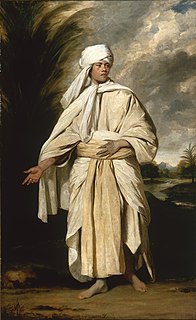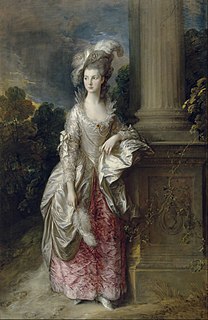
Thomas Gainsborough was an English portrait and landscape painter, draughtsman, and printmaker. Along with his rival Sir Joshua Reynolds, he is considered one of the most important British artists of the second half of the 18th century. He painted quickly, and the works of his maturity are characterised by a light palette and easy strokes. Despite being a prolific portrait painter, Gainsborough gained greater satisfaction from his landscapes. He is credited as the originator of the 18th-century British landscape school. Gainsborough was a founding member of the Royal Academy.

Chatsworth House is a stately home in the Derbyshire Dales, 3.5 miles (5.6 km) north-east of Bakewell and 9 miles (14 km) west of Chesterfield, England. The seat of the Duke of Devonshire, it has belonged to the Cavendish family since 1549. It stands on the east bank of the River Derwent, across from hills between the Derwent and Wye valleys, amid parkland backed by wooded hills that rise to heather moorland. The house holds major collections of paintings, furniture, Old Master drawings, neoclassical sculptures and books. Chosen several times as Britain's favourite country house, it is a Grade I listed property from the 18th century, altered in the 19th. In 2011–2012 it underwent a £14-million restoration. The owner is the Chatsworth House Trust, an independent charitable foundation, on behalf of the Cavendish family.

Duke of Devonshire is a title in the Peerage of England held by members of the Cavendish family. This branch of the Cavendish family has been one of the wealthiest British aristocratic families since the 16th century and has been rivalled in political influence perhaps only by the Marquesses of Salisbury and the Earls of Derby.

Georgiana Cavendish, Duchess of Devonshire, was an English socialite, political organiser, style icon, author, and activist. Of noble birth from the Spencer family, married into the Cavendish family, she was the first wife of William Cavendish, 5th Duke of Devonshire, and the mother of the 6th Duke of Devonshire.

Deborah Vivien Cavendish, Duchess of Devonshire, was an English aristocrat, writer, memoirist, and socialite. She was the youngest and last-surviving of the six Mitford sisters, who were prominent members of English society in the 1930s and 1940s.

William Cavendish, 5th Duke of Devonshire,, was a British nobleman, aristocrat, and politician. He was the eldest son of William Cavendish, 4th Duke of Devonshire, by his wife, the heiress Lady Charlotte Boyle, suo jure Baroness Clifford, who brought in considerable money and estates to the Cavendish family. He was invited to join the Cabinet on three occasions, but declined each offer. He was Lord High Treasurer of Ireland and Governor of Cork, and Lord Lieutenant of Derbyshire. The 5th Duke is best known for his first wife Georgiana, Duchess of Devonshire. At the age of about twenty, Devonshire toured Italy with William Fitzherbert which is where they commissioned the pair of portraits by Pompeo Batoni.
Events from the year 1876 in art.

Mary Alice Cavendish, Duchess of Devonshire, was a British courtier who served as Mistress of the Robes to Queen Elizabeth II from 1953 to 1967. She was the granddaughter of Prime Minister Robert Gascoyne-Cecil, 3rd Marquess of Salisbury.

An art auction or fine art auction is the sale of art works, in most cases in an auction house.

Devonshire House in Piccadilly, was the London townhouse of the Dukes of Devonshire during the 18th and 19th centuries. Following a fire in 1733 it was rebuilt by William Cavendish, 3rd Duke of Devonshire, in the Palladian style, to designs by William Kent. Completed circa 1740, it stood empty after the First World War and was demolished in 1924.
Events from the year 1783 in art.

Elizabeth Christiana Cavendish, Duchess of Devonshire was an English aristocrat and letter writer. She is best known as Lady Elizabeth Foster, the close friend of Georgiana Cavendish, Duchess of Devonshire. Elizabeth supplanted the Duchess, gaining the affections of William Cavendish, 5th Duke of Devonshire, and later marrying him. Several of her letters are preserved.

The Duchess is a 2008 historical drama film directed by Saul Dibb. It is based on Amanda Foreman's biography of the late-18th-century English aristocrat Georgiana Cavendish, Duchess of Devonshire. It was released in September 2008 in the United Kingdom. The film won the Academy Award for Best Costume Design, and was nominated for Best Art Direction.

The Cavendishfamily is a British noble family, of Anglo-Norman origins. They rose to their highest prominence as Duke of Devonshire and Duke of Newcastle.
Wynne Ellis (1790–1875) was a wealthy British haberdasher, politician and art collector.

Mrs. Richard Brinsley Sheridan (1787) is an oil on canvas portrait painted by Thomas Gainsborough between 1785 and 1787. It was acquired by the National Gallery of Art in 1937. Mrs. Sheridan was a talented musician who enjoyed professional success in Bath and London before marrying Richard Brinsley Sheridan in 1773 and abandoning her career. She was 31-33 when she sat for Gainsborough, dying from tuberculosis seven years later at the age of thirty-eight. The portrait was painted between 1785 and 1787, and, was exhibited at Gainsborough's studio at Schomberg House, Pall Mall in 1786.

Portrait of Omai is an oil-on-canvas portrait by English artist Sir Joshua Reynolds, completed c.1776.

Georgiana Dorothy Howard, Countess of Carlisle was a British noblewoman. She was born after nine years of childless marriage between William Cavendish, 5th Duke of Devonshire, and his wife, Lady Georgiana Spencer, the political hostess and socialite. As such, she was a member of one of the country's grandest and richest families.

Mr and Mrs William Hallett is a 1785 oil on canvas painting by the British painter Thomas Gainsborough, and is now in the collection of the National Gallery in London.

Portrait of Mrs Mary Graham or The Honourable Mrs Graham is a 1777 oil on canvas painting by the British artist Thomas Gainsborough, produced shortly after Mary's marriage to Thomas Graham, the future Lord Lynedoch on 26 December 1774. It was one of the first works to enter the collection of the Scottish National Gallery in Edinburgh after its bequest in 1859 by the heirs of Thomas Graham.

















